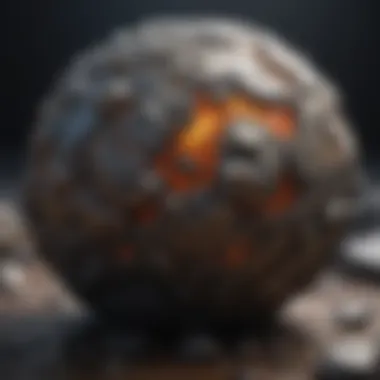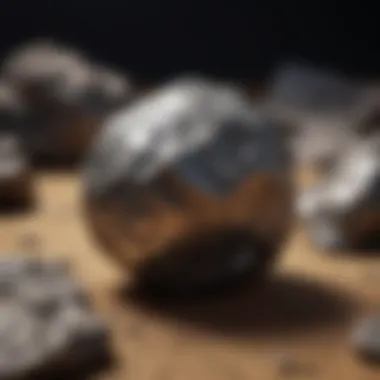Unveiling the Mystery: Mastering the Art of Identifying Meteorites


Rock and Fossil Identification
In the fascinating world of rock and fossil identification, enthusiasts are presented with a plethora of types and characteristics to explore. Differentiating between various rock types, from igneous to sedimentary, involves a keen eye for key features such as mineral composition and texture. Fossil collectors, on the other hand, dive into the remnants of ancient life forms, meticulously examining fossilized bones or imprints to uncover clues about Earth's past. To aid in this meticulous process, collectors rely on tools like magnifying lenses, chisels, and UV lights to inspect and classify their finds with precision.
Collecting Tips and Techniques
For rock and fossil collectors, embarking on collecting expeditions requires more than just enthusiasm – it demands a strategic approach. Best practices include thorough research on prime collecting sites rich in geological wonders, ensuring a higher likelihood of discovering unique specimens. Locating these sites involves studying geological maps, attending seminars, and networking with fellow collectors to access insider knowledge. When it comes to safely extracting specimens, collectors employ specialized techniques to avoid damaging valuable finds, such as using delicate tools like brushes and dental picks to excavate fragile fossils or crystalline structures.
Preservation and Display
Preservation is paramount for maintaining the integrity of rocks and fossils for future generations to enjoy. Through meticulous techniques like fossil preparing, collectors carefully remove surrounding matrix to reveal the specimen while minimizing damage. Proper storage methods involve using archival-quality materials to prevent deterioration over time, such as acid-free containers and silica gel for moisture control. Displays take creativity to the next level, with collectors showcasing their prized pieces in custom shadow boxes, LED-lit cabinets, or museum-quality stands that not only preserve but also elevate the aesthetic appeal of their collections.
Geological Insights
Delving into the geological insights offered by rocks and fossils unveils a treasure trove of discoveries waiting to be uncovered. By studying the various formations and processes that shaped our planet's landscape, collectors gain a deeper appreciation for Earth's intricate history. Rocks and fossils also hold historical significance, offering clues about ancient climates, ecosystems, and evolutionary milestones. Notable discoveries, such as unique fossil specimens or rare mineral formations, not only enrich collectors' knowledge but also contribute to the broader scientific community's understanding of our planet's past.
Introduction to Meteorites
In the realm of Earth's geological history, meteorites stand out as fascinating remnants of celestial events that captivate both scientists and collectors alike. The field of meteoritics encompasses a diverse range of studies, from understanding the origins of our solar system to unraveling the mysteries of ancient cosmic collisions. This section serves as a gateway into the enigmatic world of meteorites, shedding light on their significance and intrinsic allure. Meteorites, as extraterrestrial rock fragments that have survived their journey through Earth's atmosphere, provide a direct link to the vast cosmos beyond our planet's boundaries.
Understanding Meteorites
Definition of Meteorites
Defined as extraterrestrial objects that can withstand the journey through Earth's atmosphere and impact its surface, meteorites are treasured for the invaluable insights they offer into the history and composition of the solar system. This unique characteristic distinguishes them from terrestrial rocks, making them a cornerstone of scientific inquiry and collector fascination. The inherent exclusivity of meteorites, originating from sources beyond Earth, renders them exceptional specimens for study and admiration within the scientific community.


Importance of Identifying Meteorites
The importance of accurately identifying meteorites cannot be overstated, as they hold essential clues to understanding the formation and evolution of celestial bodies. Recognizing these cosmic visitors among the multitude of terrestrial rocks is crucial for scientific research and the preservation of these rare geological treasures. By distinguishing meteorites from common rocks, researchers can uncover valuable data about the universe's past and present, contributing significantly to our knowledge of planetary processes and cosmic phenomena.
Types of Meteorites
Iron Meteorites
Iron meteorites, characterized by their high iron and nickel content, represent a significant subgroup of meteorites renowned for their metallic composition and distinct crystalline structures. These meteorites often exhibit unique patterns that form during the cooling process, known as Widmanstätten patterns, making them prized specimens for collectors and researchers alike. The presence of iron and nickel makes iron meteorites stand out among other meteorite types, showcasing the diversity of materials inhabiting our solar system.
Stony Meteorites
Stony meteorites, composed primarily of silicate minerals and rock fragments, comprise another prevalent category of meteorites distinguished by their stony texture and diverse compositions. These meteorites can offer insights into the geological processes taking place on asteroids and other celestial bodies, broadening our understanding of planetary materials beyond Earth. Their elemental composition and mineralogy make stony meteorites valuable resources for studying the diversity of materials present in the solar system.
Stony-Iron Meteorites
Stony-iron meteorites, as hybrids of iron and stony meteorites, provide a unique perspective on the complex geological processes that shape celestial bodies. Combining the characteristics of both iron and stony meteorites, these extraordinary specimens showcase the interplay between metal and silicate components in the formation of meteoritic materials. The intricate interlocking of metallic and rocky textures in stony-iron meteorites presents a compelling area of study for researchers aiming to unravel the mysteries of planetary differentiation and the origins of our solar system.
Key Characteristics of Meteorites
In the realm of meteorite identification, understanding the key characteristics of meteorites holds paramount importance. These characteristics serve as the cornerstone for distinguishing between a space rock and an ordinary terrestrial stone. Meteorites exhibit distinct features that set them apart, making it essential for rock and fossil collectors to delve into these specifics. By focusing on the key characteristics of meteorites, enthusiasts can hone their skills in differentiating these celestial remnants from common rocks.
Metallic Content
Exploring the metallic content of meteorites unveils crucial information that aids in their identification process. The presence of iron and nickel within meteorites plays a significant role in defining their composition and unique properties. By analyzing the metallic content, collectors can observe the distinctive qualities that set meteorites apart from terrestrial formations.


Presence of Iron/Nickel
The presence of iron and nickel in meteorites stands as a defining characteristic that distinguishes them from other rocks. This high-content metallic composition is a key indicator that a rock might be of extraterrestrial origin. Iron and nickel create distinct visual patterns and structures within meteorites, setting them apart from common stones found on Earth. This characteristic feature is essential in the identification process, serving as a beacon for collectors to pinpoint potential meteorite specimens.
Fusion Crust
The fusion crust, a unique feature of meteorites, plays a vital role in their recognition and differentiation. This outer layer is formed when a meteoroid enters Earth's atmosphere, creating a distinct crust that sets meteorites apart from terrestrial rocks. Understanding the fusion crust is essential for collectors to identify genuine meteorites and distinguish them from look-alike terrestrial stones.
Explanation of Fusion Crust
The fusion crust is a thin layer covering the surface of a meteorite, resulting from the intense heat generated during atmospheric entry. This crust serves as a protective shell, preserving the interior of the meteorite from earthly elements. The fusion crust often exhibits characteristics like darkening, melting, and flow lines, providing valuable clues about the meteorite's journey through space. Recognizing and analyzing the fusion crust is vital for collectors to verify the authenticity of a potential meteorite.
Widmanstätten Patterns
Widmanstätten patterns present a fascinating aspect of meteorite identification, showcasing unique crystal structures that are a product of slow cooling over millions of years. These patterns offer an intricate insight into the formation and history of meteorites, reflecting their extraterrestrial origin through distinct geometric arrangements.
Unique Crystal Structures
The unique crystal structures found in Widmanstätten patterns represent a distinctive hallmark of meteorites. These intricate patterns arise due to the slow cooling process of nickel-iron alloys within meteorites over geologic timescales. The resulting patterns display an otherworldly beauty, characterized by intersecting crystal planes that unveil the meteorite's cosmic journey. Understanding these crystal structures is pivotal for collectors in not only differentiating meteorites but also appreciating the intricate beauty and scientific significance encapsulated within these celestial remnants.
Meteorite Identification Techniques
When delving into the realm of identifying meteorites, understanding meteorite identification techniques plays a pivotal role. The significance of this topic within the context of meteorite identification is monumental as it provides collectors with concrete methods to differentiate between meteorites and terrestrial rocks. By focusing on specific elements such as magnetism tests, density tests, and chemical analysis, enthusiasts equip themselves with the necessary arsenal to validate the authenticity of their specimens.
Magnetism Test


Exploring the Magnetism Test unveils a distinctive approach in discerning meteorites. The item 'Using a Magnet to Determine Iron Content' stands out as a key methodology in the meteorite identification process. By utilizing magnetic properties to gauge the presence of iron content, collectors can swiftly categorize potential meteorites based on their magnetic response. This test presents a beneficial choice for enthusiasts as it offers a straightforward and non-destructive method to assess iron-rich specimens. The unique feature of 'Using a Magnet to Determine Iron Content' lies in its efficiency and reliability, allowing collectors to efficiently sift through their collections without causing harm to the specimens. However, it's essential to note that while this technique offers quick insights, it should be combined with other tests for a comprehensive evaluation.
Density Test
Transitioning to the Density Test, a distinct method emerges for differentiating meteorites from ordinary rocks. 'Comparing Weight to Volume' serves as a fundamental aspect of the density test, contributing significantly to the overall goal of meteorite identification. This test's key characteristic lies in its ability to determine the density of a specimen by comparing its weight to volume ratio. The popularity of this method stems from its simplicity and accuracy in differentiating dense meteorites from terrestrial rocks. The unique feature of 'Comparing Weight to Volume' lies in its direct correlation to the material's mass, enabling collectors to infer valuable insights regarding the composition of the specimen. While advantageous in its precision, the density test may pose challenges in determining the exact composition of heterogeneous samples, necessitating additional analyses for a conclusive identification.
Chemical Analysis
The exploration of Chemical Analysis within meteorite identification techniques offers a sophisticated approach to confirming the elemental composition of specimens. 'Identifying Elemental Composition' emerges as a critical aspect in the identification process, enriching the overall scope of meteorite analysis. The key characteristic of this method lies in its ability to unravel the elemental makeup of a specimen through advanced analytical techniques. This method gains popularity due to its precision in determining the presence of specific elements characteristic of meteorites. The unique feature of 'Identifying Elemental Composition' is its capacity to provide detailed insights into the chemical signature of meteorites, aiding collectors in confirming the authenticity of their finds. Despite its advantages in elucidating intricate details, chemical analysis may be time-consuming and require specialized equipment, posing limitations in accessibility for amateur collectors.
Common Mistakes in Meteorite Identification
In the realm of meteorite identification, understanding common mistakes holds immense significance. Avoiding missteps can make all the difference between accurately identifying a meteorite or misinterpreting it as a terrestrial rock. This article delves into the pivotal topic of common mistakes in meteorite identification, shedding light on the key elements that collectors and enthusiasts should be wary of. By dissecting the errors that can occur during the identification process, readers will gain a deeper understanding of the complexities involved in distinguishing meteorites from ordinary rocks.
Misinterpreting Characteristics
Confusing Features with Terrestrial Rocks
Confusion between features of meteorites and terrestrial rocks is a prevalent issue in the field of meteorite identification. The allure of meteorites can sometimes lead individuals to spot similarities that may not necessarily indicate the extraterrestrial origin of a specimen. This subsection scrutinizes the specific aspect of confusing features with terrestrial rocks, emphasizing the importance of discerning unique characteristics that truly denote a meteorite. Understanding the distinct attributes that set meteorites apart from common rocks is crucial for accurate identification. By elucidating the intricacies of confusing features with terrestrial rocks, this article aims to equip readers with the knowledge needed to make informed decisions when differentiating between meteorites and terrestrial specimens.
Skipping Proper Testing
Skipping proper testing procedures poses a significant risk in the identification of meteorites. The importance of rigorous analysis cannot be overstated when it comes to verifying the authenticity of a potential meteorite. This section delves into the critical aspect of the importance of rigorous analysis, underscoring its indispensable role in the accurate identification of meteorites. Highlighting the necessity for meticulous examination and testing, readers will grasp the significance of adhering to systematic evaluation protocols. By emphasizing the value of thorough analysis, this article aims to steer collectors away from overlooking essential testing methods that could lead to misidentifications.
Conclusion
In this meticulous guide on how to identify a meteorite, the Conclusion serves as a vital wrap-up of the critical elements discussed throughout the article. Understanding meteorites is an intriguing field that requires a keen eye and attention to detail. As rock and fossil collectors delve into the world of meteorite identification, they are met with a myriad of key characteristics and identification techniques to differentiate these celestial rocks from common terrestrial specimens. The Conclusion section acts as the final piece of the puzzle, emphasizing the significance of thorough analysis and precise identification.
It is crucial to acknowledge the practical benefits of accurately identifying meteorites. By distinguishing these extraterrestrial rocks from typical rocks, collectors can expand their collections with unique and valuable specimens. Moreover, proper meteorite identification adds a layer of excitement and intrigue to the hobby, offering enthusiasts the opportunity to delve into the mysteries of space and time encapsulated within these cosmic fragments.
In the context of this article, the Conclusion plays a pivotal role in consolidating information and reinforcing the importance of diligence in meteorite identification. Encouraging readers to apply the discussed identification techniques with precision and care, the Conclusion ensures that aspiring meteorite hunters are equipped with the knowledge and tools necessary to embark on their quest for these celestial treasures.







